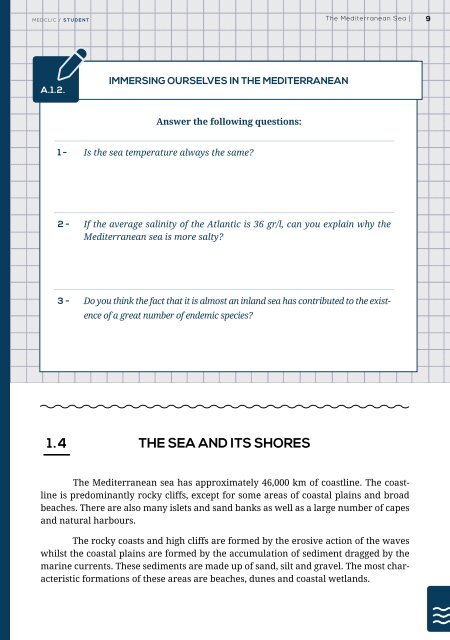u1_web_the_mediterranean_sea
Create successful ePaper yourself
Turn your PDF publications into a flip-book with our unique Google optimized e-Paper software.
MEDCLIC / STUDENT The Mediterranean Sea | 9<br />
A.1.2.<br />
IMMERSING OURSELVES IN THE MEDITERRANEAN<br />
Answer <strong>the</strong> following questions:<br />
1 - Is <strong>the</strong> <strong>sea</strong> temperature always <strong>the</strong> same?<br />
2 - If <strong>the</strong> average salinity of <strong>the</strong> Atlantic is 36 gr/l, can you explain why <strong>the</strong><br />
Mediterranean <strong>sea</strong> is more salty?<br />
3 - Do you think <strong>the</strong> fact that it is almost an inland <strong>sea</strong> has contributed to <strong>the</strong> existence<br />
of a great number of endemic species?<br />
1.4<br />
The <strong>sea</strong> and its shores<br />
The Mediterranean <strong>sea</strong> has approximately 46,000 km of coastline. The coastline<br />
is predominantly rocky cliffs, except for some areas of coastal plains and broad<br />
beaches. There are also many islets and sand banks as well as a large number of capes<br />
and natural harbours.<br />
The rocky coasts and high cliffs are formed by <strong>the</strong> erosive action of <strong>the</strong> waves<br />
whilst <strong>the</strong> coastal plains are formed by <strong>the</strong> accumulation of sediment dragged by <strong>the</strong><br />
marine currents. These sediments are made up of sand, silt and gravel. The most characteristic<br />
formations of <strong>the</strong>se areas are beaches, dunes and coastal wetlands.




